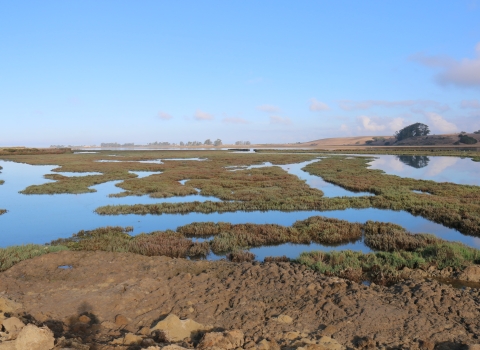Arcata, Calif. - The U.S. Fish and Wildlife Service is proposing to list the Lassics lupine, a plant species found only in northern California as endangered under the Endangered Species Act, with a critical habitat designation. Public comments will be accepted for 60-days after the proposed rule publishes, or until December 5, 2022.
Primary factors contributing to the plant’s decline include woody vegetation encroachment, pre-dispersal seed predation, catastrophic wildfire, and reduced soil moisture due to drought associated with ongoing climate change climate change
Climate change includes both global warming driven by human-induced emissions of greenhouse gases and the resulting large-scale shifts in weather patterns. Though there have been previous periods of climatic change, since the mid-20th century humans have had an unprecedented impact on Earth's climate system and caused change on a global scale.
Learn more about climate change .
Lassics lupine is a tap-rooted, herbaceous perennial that grows to a height of less than six inches tall. The pink and white flowers of Lassics lupine are pea-like and composed of five unique petals. The flowers provide nectar for many pollinator species, including three types of native bees. The perennial is known to occur at high elevations around Mount Lassic and Red Lassic on the border of Humboldt and Trinity counties in northern California.
The Service is also proposing to designate approximately 512 acres of critical habitat for Lassics lupine on Six River National Forest in portions of Humboldt and Trinity counties. Lassics lupine occurs entirely on land managed by the U.S. Forest Service.
“Lassics lupine is a special perennial that only occurs in the remote mountainside soils of northern California,” said Tanya Sommer, Field Supervisor of the Arcata Fish and Wildlife Office. “Because it has such a narrowly defined habitat, any habitat loss represents a serious threat. We’re grateful for our partnership with Six Rivers National Forest focused on conservation and habitat management; this joint effort will be crucial for recovery. Although this rare plant does need our help, we are optimistic about its prospects.”
Using the best available science, the Service evaluated the status of Lassics lupine and determined it warrants protection. The ESA is extraordinarily effective at preventing species from going extinct and has inspired action to conserve at-risk species and their habitat before they need to be listed as threatened or endangered. Since it was signed into law in 1973, more than 99 percent of all species listed under the law are still with us today.
The proposed rule will publish in the Federal Register on October 6, 2022. Comments will be accepted until December 5, 2022. Requests for public hearings must be submitted in writing no later than November 21, 2022.
Information on how to submit comments is available at www.regulations.gov by searching under docket number: FWS-R8-ES-2022-0083.
You can also submit comments and information, or a hearing request in writing to: Public Comments Processing, Attn: FWS-R8-ES-2022-0083, U.S. Fish and Wildlife Service, MS: PRB/3W, 5275 Leesburg Pike, Falls Church, VA 22041–3803.
The U.S. Fish and Wildlife Service works with others to conserve, protect, and enhance fish, wildlife, plants, and their habitats for the continuing benefit of the American people. For more information about our work and the people who make it happen, visit https://www.fws.gov/cno/or connect with us via Facebook, Twitter, YouTube, and Flickr.


